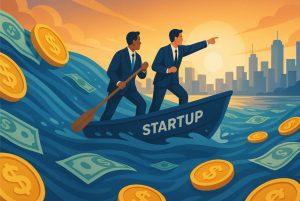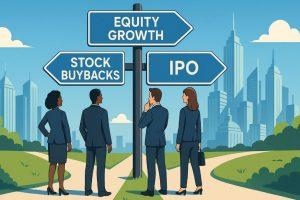In the competitive world of startups, decisions surrounding financial strategy are as crucial as product development and market expansion. One topic that surfaces as startups mature is whether to distribute dividends to shareholders.
For many, dividends seem out of reach in the early stages. However, understanding when and why startups might pay dividends is vital for both founders and investors. This guide examines the conditions, strategies, and considerations that influence dividend policies in the startup ecosystem.
What Exactly Are Dividends?

Dividends are a share of a company’s profits allocated to its shareholders, commonly issued either as cash payouts or additional equity. In established firms, dividends signal financial health and reward investors. For startups, however, the concept takes on a different dynamic due to their focus on aggressive growth and reinvestment.
Types of Dividends Startups Might Encounter
Startups may encounter different dividend forms, such as cash dividends, stock dividends, and property dividends. Cash dividends are the most common, while stock dividends involve issuing new shares to existing shareholders.
Integrating Dividends into Startup Financial Planning
Understanding the role of dividends early can help founders prepare for future financial structuring, particularly when developing long-term shareholder strategies.
Builds Investor Trust in Startups
Even if dividends are not immediate, knowledgeable founders who address dividend potential earn investor trust by demonstrating comprehensive financial foresight.
Why Don’t Most Startups Distribute Dividends in Their Early Years?
Startups prioritise growth over profit distribution, especially during the initial stages when cash flow and profitability are not stable.
The Cost of Early Dividend Payments
Issuing dividends too soon can divert vital resources from product development, market expansion, and talent acquisition critical factors for long-term survival.
Investor Expectations in Early-Stage Startups
Venture capitalists and angel investors typically seek high-growth trajectories, preferring startups to reinvest earnings to maximise future valuations rather than issue dividends.
Market Competition and Resource Allocation
Early-stage startups often operate in fiercely competitive environments. Allocating resources towards strategic initiatives rather than dividends improves a company’s chances of capturing and maintaining market share.
At What Stage Can a Startup Realistically Start Paying Dividends?
Dividends become a feasible option once a startup matures and achieves financial and operational stability.
Signs a Startup Is Ready to Pay Dividends
Stable profits, predictable revenue streams, and declining marginal returns on reinvestments indicate readiness to consider dividend policies.
The Role of Financial Audits and Forecasting
Reliable financial statements and forecasts can help founders assess the sustainability of proposed dividend payouts.
Timing for Dividend Initiatives
Announcing dividends at the wrong time could damage investor confidence if financial performance deteriorates afterward.
Milestones for Dividend Consideration
| Milestone | Details |
| Consistent Profitability | Sustained earnings over multiple fiscal periods. |
| Positive Cash Flow | Ability to cover operational costs and obligations comfortably. |
| Market Maturity | Stabilised market share with limited competition. |
| Growth Plateau | Declining returns on reinvestment signal alternative uses for profits. |
Which Financial Metrics Should Startups Analyse Before Paying Dividends?

Before paying dividends, startups must thoroughly evaluate key financial indicators to ensure payments are sustainable.
The Importance of Cash Flow Analysis
Strong operating cash flow ensures that dividends can be paid without jeopardising business operations or forcing debt reliance.
Evaluating Net Profit Margins
High and stable net profit margins suggest that a business is efficiently converting revenues into actual profits, bolstering dividend feasibility.
Assessing Debt Levels
Low debt levels reduce financial risk and make dividend issuance less contentious with lenders or creditors.
How Can Startups Balance Growth Ambitions with Dividend Payouts?
Maintaining equilibrium between reinvesting for expansion and rewarding shareholders is essential for ensuring lasting business success.
Partial Dividend Policies as a Middle Ground
Some startups adopt a policy of paying modest dividends while continuing to invest heavily in growth initiatives.
Growth Opportunities vs. Shareholder Pressure
Founders must navigate the tension between pursuing strategic expansions and satisfying investor expectations for returns.
The Importance of Flexible Dividend Strategies
Flexible or adjustable dividend policies can provide stability without locking the company into unsustainable financial commitments.
Is Profitability the Only Factor for Startups to Pay Dividends?
While necessary, profitability is not the sole determinant in deciding whether to pay dividends.
The Impact of Business Model Stability
Startups with predictable, recurring revenue models may be more comfortable offering dividends compared to those in volatile sectors.
Investor Demographics and Their Expectations
Different types of investors have different expectations. Private equity investors might prioritise dividends more than venture capitalists.
External Market Conditions
Economic cycles and broader market conditions can influence the wisdom of paying dividends. In downturns, preserving cash may be more critical.
How Does Cash Flow Health Influence a Startup’s Dividend Decisions?

Without strong cash flow, even profitable startups risk liquidity crises if they pay out dividends.
Cash Flow More Than Profit
A business could show profits on its income statement but face cash shortages that jeopardise its operations if cash flow is not managed properly.
Managing Working Capital Efficiently
Effective management of receivables, payables, and inventories ensures cash availability for potential dividend distribution.
Setting Cash Reserves for Contingencies
Building adequate cash reserves is essential before initiating any dividend payout to cushion against unforeseen disruptions.
Do Venture Capital-Backed Startups Ever Pay Dividends?
Generally, venture capital-backed startups refrain from paying dividends to preserve capital for growth.
VC Investment Philosophy
Venture capitalists prioritise high-return exits like IPOs or acquisitions, where profits are realised from valuation increases, not regular income.
Dividend Restrictions in VC Agreements
Many VC term sheets include clauses that restrict or disincentivise dividend payments during the investment period.
VC-Backed Startup Dividends
In rare cases, if a startup generates significant cash flow without attractive reinvestment opportunities, VCs might agree to a one-time dividend.
How Do Dividend Payments Impact Startup Valuation and Investor Perception?
Dividend decisions can influence both internal valuations and external perceptions of the startup’s prospects.
The Positive Signals of Dividends
For investors who value stability and predictability, dividends can enhance confidence in a startup’s financial health.
Potential Negative Interpretations
Some investors view dividends as a sign that a company has exhausted its growth potential, leading to concerns about stagnation.
Balancing Dividend Signals with Growth Narratives
Founders must ensure that dividend announcements align with the company’s broader growth and innovation messaging.
What Are the Best Alternatives to Dividends for Startup Investors?

Since dividends are often impractical, startups can pursue alternative strategies to reward investors.
Equity Appreciation Through Growth
As a startup scales, the appreciation in share value offers investors significant returns upon exit events.
Stock Buybacks to Increase Share Value
Buying back shares reduces supply, which can elevate share price and indirectly reward investors without cash distributions.
Liquidity Events as Exit Strategies
Mergers, acquisitions, or IPOs offer substantial returns, often far exceeding what dividend payments could provide.
What Key Considerations Should Founders Weigh Before Declaring Dividends?
Founders must approach dividend policies with caution and strategic insight.
Alignment with Business Objectives
Any dividend strategy should align closely with the startup’s broader vision and future growth objectives, avoiding conflicts with its strategic goals.
Shareholder Structure and Preferences
Understanding the makeup of the shareholder base helps in setting policies that meet the majority’s expectations.
Regulatory Compliance and Legal Obligations
Dividends must be compliant with local corporate laws, ensuring that the company remains solvent and meets fiduciary duties.
How Does a Startup’s Lifecycle Shape Its Dividend Strategy Over Time?
The maturity and stage of the startup directly influence its approach to dividends.
Early Stage Focus on Growth
Startups in their infancy typically reinvest every available pound into achieving product-market fit and scaling operations.
Mature Companies and Dividends
As startups achieve operational stability and enter maturity, offering dividends emerges as a practical option to meet investors’ expectations for regular income.
Exit and Beyond
Following an IPO or acquisition, startups may fully transition into dividend-paying companies to attract a broader shareholder base.
| Stage | Dividend Strategy |
| Seed and Startup | No dividends; focus entirely on growth. |
| Growth | Continued reinvestment; consider dividends only if profitable. |
| Maturity | Potential introduction of moderate, regular dividends. |
| Exit (IPO/Sale) | Returns realised via liquidity event rather than dividends. |
Can Startups Offer Special Dividends and How Do They Work?

Special dividends provide a flexible, one-time way to reward shareholders without committing to regular payouts.
Triggers for Special Dividend
Windfall profits from a major sale, a legal settlement, or operational overperformance can justify a special dividend.
Advantages of Special Dividends for Startups
They allow startups to distribute excess profits without affecting their long-term reinvestment capabilities or financial stability.
Risks Associated with Special Dividends
Misjudging the timing or scale of a special dividend can lead to cash shortages or signal mismanagement to the market.
How Do Dividend Policies Differ Between Private and Public Startups?
Dividend practices differ widely depending on whether a startup is privately held or publicly traded.
Investor Expectations in Private vs Public Companies
Private investors focus on capital appreciation, while public investors often seek regular income, influencing dividend strategies.
Disclosure and Transparency Requirements
Public companies must disclose dividend policies and adhere to stricter regulatory scrutiny, unlike private firms.
Liquidity Considerations
Publicly traded startups offer liquidity through stock markets, which can compensate for a lack of dividends, unlike private companies.
What Are the Tax Implications of Startup Dividend Payments for Investors?
Tax policies can influence the desirability of dividends compared to other forms of return.
UK Dividend Taxation Overview
As of 2025, UK investors have a £500 tax-free dividend allowance, after which dividend income is taxed at rates lower than regular income.
Impact on International Investors
Cross-border dividend payments can trigger withholding taxes, making it essential for startups to provide guidance to foreign shareholders.
Startups Can Assist Investors
Offering clear, concise information on tax implications enhances investor relations and ensures compliance with legal frameworks.
Conclusion
Ultimately, founders must align dividend decisions with their startup’s mission and stage of development. For most, reinvestment remains paramount until growth levels plateau. Dividend policies, if introduced, should be flexible, sustainable, and transparently communicated to ensure they enhance, rather than hinder, the company’s long-term prospects.
FAQs About When Do Startups Generally Pay Dividends?
What conditions must be met for a startup to start paying dividends?
A startup should demonstrate consistent profitability, strong cash flow, limited reinvestment opportunities, and market stability before considering dividend payments.
Can startups pay dividends if they are not profitable?
Startups rarely pay dividends without profitability, as doing so can drain essential resources and jeopardise financial health.
Are dividend-paying startups viewed differently by investors?
Yes, dividend-paying startups may be seen as financially mature, but could also be perceived as having limited growth potential.
Do early-stage startups ever offer dividends?
It is uncommon. In their early phases, startups usually focus on reinvesting earnings to accelerate growth and fortify their standing within the market.
How does dividend policy affect startup funding rounds?
A formal dividend policy may deter growth-focused investors who prefer funds to be reinvested rather than distributed.
Are there legal risks associated with paying dividends in startups?
Yes, startups must comply with local corporate laws and ensure that dividends do not breach loan covenants or lead to insolvency.
What are safer alternatives to dividends for rewarding startup investors?
Equity growth, stock buybacks, and liquidity events like IPOs or acquisitions often offer more attractive returns for startup investors.









Leave feedback about this